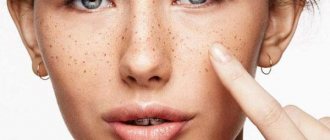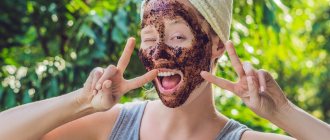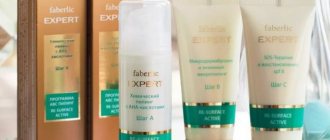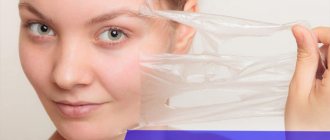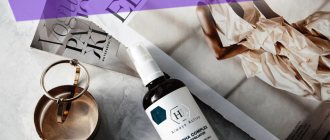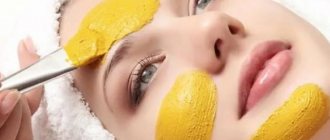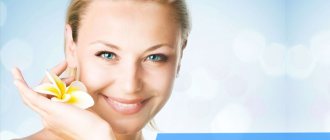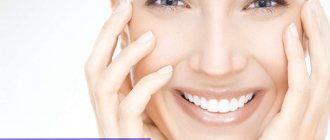Problem skin requires special attention. Blackheads, pimples, acne and other defects on the dermis not only spoil the appearance, but also cause psychological discomfort.
Experts offer many options for dealing with such problems, but peeling for acne is considered the most productive. It has a strong cleansing effect on the skin, improving its appearance. As a result, the relief is evened out, post-acne marks become less noticeable, and inflammation decreases.
However, it is important to know that anti-acne peeling will only be effective if it is correctly selected and performed in accordance with all the rules and recommendations of experts.
What kind of peeling helps to eliminate unwanted rashes?
Pimples and blackheads - almost every woman faces this problem. Acne can occur on absolutely any skin; women over 30–40 years of age often suffer from the defect. The culprits of unpleasant rashes are clogged sebaceous glands and the lard itself, which has acquired a thick consistency.
Today, aesthetic cosmetology offers many techniques, both professional and for home use, that can get rid of acne, enlarged pores and blackheads. Exfoliation procedures cleanse the mouth of sebaceous plugs and deprive bacteria of a nutrient medium, eliminate inflammatory processes, and prevent exacerbations of acne.
Acne peelings are:
- Chemical (enzyme and acid).
- Mechanical.
- Hardware.
Mechanical cleaning is a rather rough and painful procedure. It severely damages the skin and requires a long recovery period. It is used only for deep (sore) single pimples and severe post-acne.
An alternative to mechanical action is hardware exfoliation. The procedure copes well with stagnant spots, purulent rashes and traces of acne, but is more often prescribed to patients with a few acne.
If the problem is acute, and the rashes are abundant and aggressive, it is better to choose chemical peeling. Acidic compounds disinfect and dry oily skin and tighten pores. But their main advantage lies in their non-traumatic effect on the dermis and their inability to spread infection throughout the face.
For minor defects, almond exfoliation can be used. This is a great option for young, problematic skin with small acne spots and enlarged pores. The procedure gently and effectively cleanses the face, fights oiliness, brightens and evens out the texture, and has virtually no restrictions or complications. Recommended for girls over 16 years old.
Features of problematic epidermis
If the peeling is not chosen correctly, the skin can be injured and inflammation will spread to the entire surface of the face.
Therefore, it is better to entrust the choice of procedure to a cosmetologist who will assess the condition of the skin during examination and prescribe the appropriate type of cleaning.
Sometimes external inflammation indicates internal problems of the body; the doctor recommends eliminating the cause of the rash, and only then treating the consequences in the form of acne.
Otherwise, the rash will constantly progress. Choosing the right cleanser depends on the type of acne.
There are three groups of inflammations in total:
- comedones (blackheads);
- internal acne;
- acne (purulent inflammations of various sizes).
Very often, those with oily skin experience several types of acne at the same time.
Peeling can quickly deal with the problem and eliminate it completely.
Dermatologist-cosmetologist Irina Kotova talks about the care and treatment of problem skin:
Indications and contraindications for the procedure
Of course, one of the main indications for the use of acne peeling is blackheads and acne vulgaris. But these are far from the only problems that exfoliation can solve. No less often, the procedure is prescribed for the following defects:
- dermatological diseases (solar keratosis, hyperkeratosis, eczema, seborrhea, melasma);
- ingrown hairs after hair removal;
- signs of age (sagging skin, facial wrinkles, senile pigmentation);
- hyperfunction of the sebaceous glands;
- enlarged pores;
- dull complexion;
- post-acne, small scars and cicatrices.
Exfoliation can help get rid of acne on your chest and back. Indications for use are expanded by prescribing superficial peels as preparatory measures for other, more serious cosmetic procedures.
Limitations should also be mentioned here. The list of main contraindications includes:
- individual intolerance to exfoliant components;
- exacerbation of the herpes virus;
- fresh tan;
- psoriasis;
- skin damage in the treatment area;
- neurological diseases (epilepsy);
- malignant neoplasms;
- fever;
- chronic pathologies in the acute stage;
- pregnancy and lactation;
- heart problems, presence of a pacemaker.
The limitations discussed apply to all types of acne peeling. Most exfoliations are recommended to be carried out only in the autumn-winter season, when solar activity is minimal.
Taking Acnecutane is also a contraindication to the procedure. During treatment with the drug and for 6 months after its completion, it is highly undesirable to carry out any aggressive manipulations with the skin.
Precautionary measures
Fruit peels are not recommended for active inflammation. If you have fresh acne, it is better to prefer salicylic, retinoic or Jessner.
All peels are contraindicated during pregnancy and breastfeeding, or during the acute stage of herpes. If you have kidney or liver failure, diabetes, or problems with the thyroid gland, you should consult a specialized doctor before the procedure.
After the procedure, be sure to follow the rules of hygiene: wash makeup brushes, use disposable towels, wipe your mobile phone with alcohol, change your pillowcase to prevent infection on the renewed skin.
Chemical peeling
Acid peels for acne are considered the best choice for extensive lesions on the face and back. The method is based on exfoliation of the dermis with various types of acids, both alone and in combination with each other. The effectiveness of the effect depends on the concentration of enzymes and the depth of their penetration into tissues.
Glycolic acne peeling
The basis of this exfoliation is glycolic acid, which is an alpha hydroxy acid and performs a dual function - cleansing sebaceous ducts and rejuvenating the skin. The procedure is ideal for women over 30 years old who suffer from post-acne and periodic rashes.
Glycolic peeling can be:
- Superficial - performed with a solution with a concentration of up to 25%. Prescribed for oily, problematic dermis with single pimples.
- Medium - indicated for serious structural changes, wrinkles and severe acne.
Exfoliation usually takes 20-30 minutes and is carried out according to a strict protocol. The solution can be applied in several layers, the exposure of each of which depends on the sensitivity of the patient's skin. The procedure is performed only in autumn and winter.
Fight acne with salicylic acid
For young acne-prone skin, exfoliation with salicylic acid is the best choice. The enzyme has a pronounced antiseptic, drying and keratolytic effect, destroys bacteria, brightens and evens out the complexion.
Salicylic exfoliation can be superficial (15%) and medium (20,25,30%). The penetration depth depends on the selected solution concentration and the expected effect.
Multi-acid peeling for clear skin
Multi-acid exfoliations performed with solutions with a combined composition are very popular among patients. In addition to lasting and effective relief from acne, alpha hydroxy acids stimulate the production of elastin and collagen, perfectly moisturize and rejuvenate the skin.
A mixture of active enzymes is used not only for the face, but also for the body, eliminates rashes on the back and chest, tightens the neck and décolleté.
The following combined exfoliants provide an excellent cleansing and toning effect:
- Jessner peeling. Contains lactic and salicylic acids;
- Acne Peeling Gel (Anti-acne peeling) from Natinuel (Natinuel). Contains a complex of fruit enzymes (glycolic, mandelic, pyruvic), azelaic (carboxylic) and salicylic acids;
- Keratoregulating exfoliant Renophas (Renofaz). Includes salicylic and glycolic acids. Gives a double effect - eliminates inflammatory processes and increases skin turgor.
Multi-acid peels are performed only in autumn and winter. The procedures provide an excellent whitening effect and require the use of sunscreen during the recovery period. More suitable for mature dermis with rashes.
Skin care rules after exfoliation
As practice shows, 85% of unpleasant consequences after peeling on problem skin occur due to improper rehabilitation care.
For problem skin, it is always necessary to select creams and serums marked non-comedogenic (do not clog pores). But not all manufacturers care about labeling their products.
Important! Comedogenic components are contraindicated for women with acne, as they can aggravate the situation. Undesirable ingredients: talc, lanolin, alcohol denatured alcohol, oils (castor, cocoa, coconut, wheat germ, peanut, sunflower, soybean), butyl stearate, caprylic acid.
The skin, cleansed, renewed, thinned after peeling, absorbs all care products well. It is important to double-check all household cosmetics to avoid causing acne relapse.
The peeling product itself may contain risky ingredients. The exposure time of the product on the skin is too short for the pores to become clogged.
After glycolic and “yellow” peeling, cosmetologists can prescribe a cream with antibiotics (erythromycin, synthomycin, clindamycin) for an anti-inflammatory effect.
To speed up skin renewal, it is advisable to use ointments or mousses with panthenol, hyaluronic serums, and nourishing creams with safe oils.
You need to choose sun protection products especially carefully, preferably with physical or mineral SPF filters (zinc oxide, titanium dioxide). UV protection is a mandatory step in skin care after peeling.
Mechanical method
Mechanical cleaning is the most accessible, but at the same time the most traumatic manipulation. Salons most often offer brosage or dermabrasion.
Brossage is done using brushes rotating in a given mode. The attachments exfoliate the surface layer of the skin, smooth out the relief, improve blood circulation in the epidermis and accelerate cell renewal.
Microdermabrasion is performed using microscopic crystals of aluminum oxide. The procedure not only removes the top layer of the epidermis, but also accelerates cell regeneration, eliminates signs of post-acne, and makes the face more youthful and elastic.
Often women perform mechanical exfoliation on their own, using store-bought or homemade scrubs - salt, sugar, soda, coffee.
Most cosmetologists have a negative attitude towards mechanical peeling as a way to cleanse oily skin with a lot of rashes. Experts believe that injury to the inflamed and irritated epidermis can lead to a powerful spread of infection throughout the face.
It is not advisable to do mechanical exfoliation even if you have dry, thin skin. It is better to replace the aggressive procedure with hardware exfoliation - a less traumatic and at the same time effective method of cleaning. The technique delicately eliminates defects, dries, and gets rid of acne and blackheads.
Is it possible to do it yourself?
The peculiarity of the chemical composition is its gentle, superficial effect on the skin. For this reason, women often use Anti-acne peeling on their own. Simple and clear instructions on the packaging make it easier to exfoliate your skin at home.
However, the possibility of misuse of the drug still exists. If you don’t want to take risks, trust your face to an experienced cosmetologist who will correctly calculate the dosage and time for keeping the composition on your face.
Judging by the reviews, many girls prefer to do the peeling themselves. After all, such a procedure is several times cheaper than in a salon, where the final cost includes the labor and qualifications of a cosmetologist.
Hardware peelings for acne-prone skin
For problematic dermis with acne, non-contact exfoliation options are often used, such as gas-liquid, laser or ultrasound exfoliation.
Laser peeling for acne
The procedure is performed with a laser beam, which burns the upper layer of the dermis. As a result, the skin is renewed, takes on a healthy and smooth appearance, and stagnant spots and acne disappear.
Two types of laser are used for exfoliation:
- Hot (carbon dioxide). It injures tissue quite noticeably and requires a long recovery period. The process is accompanied by thermal burns and severe redness of the skin;
- Cold (erbium). It acts in a targeted manner, burning only defective areas. A gentle and soft procedure, suitable for thin, sensitive skin.
If you want to combine acne clearing with anti-aging, try laser diamond resurfacing. The manipulation is a hypoallergenic type of exfoliation and does not cause pain.
Ultrasonic peeling
Ultrasound cleaning is indicated for patients with thin, dry facial skin. This is the most gentle and least traumatic procedure. Non-contact exfoliation effectively destroys pathogenic microflora and localizes the inflammatory process, without damaging the tissue at all. Prescribed to young women with minor skin defects.
Gas-liquid type of influence
Oxygen treatment can be done for any condition of the epidermis. The main thing is to correctly select the exposure time and the strength of the jet pressure.
Drops of an antiseptic solution moving at great speed acquire the properties of solid particles and have an abrasive, cleansing, slightly massage effect. As a result, blood circulation improves, the tone and texture of the face are evened out.
How much does acne peeling cost in a salon?
The price of acne peeling largely depends on the area of the treated area, the status of the beauty salon and the qualifications of the specialist. When performing chemical cleanings, the cost of the procedure includes the purchase of an exfoliant.
The following table will help you navigate the metropolitan prices for acne peels:
| Procedure name | Peeling type | Cost per session, rub. |
| Glycolic exfoliation | acid | 1500 – 3300 rub. |
| Salicylic exfoliation | acid | 2900 – 3900 rub. |
| Multi-acid peeling | acid | 1000 – 3000 rub. |
| Laser cleaning | hardware | 5000 – 8000 rub. |
| Ultrasonic cleaning | hardware | 2100 – 2500 rub. |
| Gas-liquid exfoliation | hardware | 2800 – 3500 rub. |
| Diamond laser grinding | hardware | 1000 – 3500 rub. |
| Retinoic cleansing | acid | from 3000 rub. |
| TCA peeling | acid | 3000 – 5500 rub. |
TABLE OF TREATMENT METHODS BY TYPE OF ACNE
| PROBLEM | TREATMENT METHOD |
|
|
|
|
|
|
How to exfoliate problem skin at home
Today, the cosmetic market is ready to offer many effective and inexpensive products for independent use. All of them are safe and easy to use, perfectly cleanse the skin and get rid of blackheads for a long time. You can buy homemade facial peeling for acne at a pharmacy or specialty store.
Let's look at several ready-made cosmetic products that are most in demand among women:
- Cleansing gel from the Korean brand Holika Holika. Designed for delicate care of problematic facial skin. Its effectiveness is confirmed by numerous customer reviews.
- Peeling lotion Mp acne peel (Aknepil) from the Israeli company GIGI. Cleanses and dries the dermis, fights acne and hyperkeratosis, tightens pores.
- ABC peeling from Faberlic (Faberlic). This three-step cleansing system is extremely popular and easily replaces a salon procedure.
- Glycolic peeling. To do it at home, purchase a 15% or 20% glycol solution.
- Anti-acne Peeling (Anti-acne) from the French company Algologie (Algologie). The drug has a cumulative effect, so you will see the result only after completing the cleansing course.
When exfoliating yourself, you must carefully read the instructions and strictly follow the procedure protocol.
To get the maximum effect from the exfoliants discussed, it is better to use them in autumn and winter.
Homemade beauty recipes
There are many excellent recipes for acne peels that are easy to make yourself. Let's look at the most interesting and effective ones.
Soda-salt scrub
Components:
- finely ground salt - 1 tbsp. l.;
- baking soda - 1 tbsp. l.;
- sour cream or cream - 1 tbsp. l.
Mix the ingredients carefully and apply to cleansed face with massaging movements. Leave for 5 minutes, rinse with acidified water.
Mask with badyaga
Badyaga is considered the best remedy for cleansing the skin at home. It perfectly removes acne, stagnant spots, brightens and evens out the face.
To prepare the mask, take:
- badyagi powder - 1 tbsp. l.;
- hydrogen peroxide solution (3%) - 1 tbsp. l.
Mix everything and apply to your face, rubbing gently. After drying, shake off the mask or rinse with water.
Calcium chloride cleansing
Another popular way to cleanse the skin. To carry out peeling, prepare a 5 or 10% calcium chloride solution and baby soap. Using a cotton pad, apply several layers of the medicinal substance to your face and wait until the drug dries. Then, using your fingers or a gauze pad, rub baby soap, whipped into foam, into the skin.
After the appearance of pellets and a “creaking” sensation, rinse off the composition and apply a nourishing or moisturizing cream.
Red Moroccan clay Ghassoul
This multifunctional mineral product is used to prepare therapeutic masks and rubs. The natural product cleanses pores, eliminates inflammation and improves tissue metabolism.
To prepare the medicinal composition you will need:
- Gassul clay - 2 tsp;
- liquid honey - 1 tsp;
- freshly squeezed lemon juice - 1 tsp.
Mix the ingredients and apply to your face. Massage and leave for 12-15 minutes. Rinse with warm water, apply cream. If the skin is dry, add sour cream or butter.
Description of the drug
Algologie peelings were developed by the French laboratory of the same name. She creates cosmetics based on seaweed and salt, as well as other similar ingredients. This is no coincidence: production is established near the coastline of Brittany (a historical region of France).
All Algolodgy peelings are professional preparations. They act superficially on the skin.
Anti-acne Peeling is a multi-acid product with a pH of 1.50. It contains citric, salicylic and trichloroacetic acids (each in a concentration of 5%), as well as lactic acid (4.5%). In addition, the peeling contains extracts of ivy, nasturtium, sage, burdock, algae, etc. This complex helps relieve the skin of the following problems:
- acne in the inflammatory phase;
- post-acne;
- infiltrates;
- stagnant spots.
Anti-acne Peeling Algologie is suitable for problematic and oily skin. It dissolves and removes dead skin cells, improving the appearance of the epidermis, but without causing active peeling. The components included in the drug have a calming, anti-inflammatory, and bactericidal effect.
Peeling is available in plastic ampoules of 3 ml - just for one procedure. The cost of 1 ampoule is about 400 rubles. A package of 10 pieces will cost 3800–4000 rubles. The representative of the Algologie brand in Russia is the Smart Buy company. She sells products only to professionals (registration on the site is required). You can also buy drugs in other online stores.
Attention! It is advisable to do chemical peelings after 25–30 years, after consulting with a cosmetologist. He will also tell you which most delicate medications are suitable for treating acne in adolescents and young people under 25 years of age.
Can peeling get rid of acne scars?
Any of the medium and deep peels is effective in correcting small hypertrophic and atrophic scars and scars. It is recommended to carry out the acne removal procedure in a beauty salon. Properly selected exfoliation will help reduce skin defects in several sessions.
For fresh or subtle scars, medial exfoliation is usually used. Deep peeling for post-acne is prescribed in extreme cases.
For young skin prone to scarring, experts recommend taking a course of coral peeling. The procedure carefully removes the top layer of the epidermis and smoothes out scars.
Retinoic acne cleansing
This exfoliation option is often used to correct scars and resolve stagnant spots. Yellow peeling provides quick and uniform cleansing of the dermis, reduces sebum production and prevents the appearance of pimples, but often causes an allergic rash.
Frequent peeling with retinoic acid can lead to drying and thinning of the epidermis, so you should not get carried away with the procedure.
The effectiveness of TCA peeling against scars and scars
To remove traces of acne, glycolate is added to an exfoliant with trichloroacetic acid. The substance effectively softens and exfoliates scar tissue, leaving the skin smooth and even. After just 4-5 sessions, the first results of TCA peeling appear. However, you shouldn’t get carried away with it either. The procedure significantly injures the dermis, so it is not recommended to perform it more than once a month.
Laser acne removal
Laser peeling for scars and acne scars has a good effect and is less painful compared to acid exfoliation.
On the first day after the procedure, the dermis will turn red and crust over, but after 4-5 days the dead layer will peel off, and you will see smooth skin without scars.
To consolidate the effect, experts advise doing at least 3 laser resurfacing procedures.
Recommendations from cosmetologists
Taking a course of peelings and getting rid of pimples and acne marks is half the battle. To get a really good and lasting result, you need proper post-peeling care.
Cosmetologists recommend strictly following the following rules after each exfoliation session:
- refuse to visit the solarium, bathhouse, sauna, swimming pool;
- hold off on going to the gym;
- protect treated skin from ultraviolet radiation, frost and wind, be sure to use sunscreen;
- Apply moisturizing and regenerating creams to your face daily.
The duration of the rehabilitation period depends on the depth of exposure and can range from 1 week to 3 months.
Answers on questions
Does peeling always help with acne?
Like any cosmetic procedure, acne peeling does not always give the expected effect. This is not only due to an incorrectly selected exfoliant or the hand of a cosmetologist.
If acne is caused by hormonal imbalance, problems with the gastrointestinal tract or demodicosis, cleansing is unlikely to help. Moreover, the procedure will most likely provoke a severe exacerbation.
But if acne appears as a result of improper functioning of the sebaceous glands, exfoliation will only bring benefits and relieve many problems.
Why did I get acne after the procedure?
There may be several reasons. Some of them are directly related to the exfoliation process, others have nothing to do with it.
Most often, the appearance of acne is a normal and natural process of skin restoration. Under the influence of third-party intervention, blood circulation improves, metabolic activity increases and, as a result, rapid maturation of subcutaneous seals occurs. According to patients, after 12–14 days, acne disappears and does not appear again.
If the inflammatory process does not subside and the pustules continue to actively grow, the cause should be sought in internal diseases of the body. The first thing to do in this case is to refuse further procedures and contact a dermatologist to prescribe specific treatment.
Can there be complications after peeling and what are they?
Yes, complications after exfoliation do occur. Moreover, each type of peeling has its own consequences. For example, if the acid exfoliation protocol is not followed, there is a high risk of burns, demarcation lines, persistent redness, and hyperpigmentation.
Laser exfoliation has its own complications:
- multiple atrophic scars (gauze effect);
- hemorrhages on the surface of the skin (bloody dew);
- redness and swelling of tissues;
- blisters with bloody or serous contents.
There are also general complications that can appear with any of the peels: exacerbation of herpes, allergic reactions, keloid and hypertrophic scars. All these defects require additional treatment.
Patient reviews
The forums are full of positive reviews about peelings from owners of problem skin. This is truly one of the few effective acne treatments.
Girls who did not carefully select the drug and type of peeling complained about the lack of the desired effect.
Girls who were not warned about post-procedure care tactics speak negatively about the procedure.
